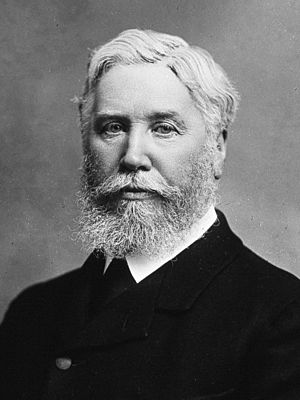James Bell Pettigrew facts for kids
Quick facts for kids
James Bell Pettigrew
|
|
|---|---|
 |
|
| Born | 26 May 1834 Roxhill, Calderbank, Lanarkshire
|
| Died | 30 January 1908 (aged 73) |
| Nationality | Scottish |
| Citizenship | United Kingdom |
| Education | University of Glasgow; University of Edinburgh |
|
Notable work
|
Design in Nature; Animal Locomotion: or Walking, Swimming and Flying |
| Medical career | |
| Institutions | Royal Infirmary of Edinburgh; Hunterian Museum; Royal College of Surgeons of Edinburgh; University of St Andrews |
| Research | Anatomy; Pathology |
| Awards | Croonian Lectures |
James Bell Pettigrew (born May 26, 1834 – died January 30, 1908) was a smart Scottish scientist. He studied the human body and nature. He was also a pioneer in understanding how animals fly.
Pettigrew was a famous naturalist in Britain. He taught Anatomy at St Andrews University from 1875 until he passed away. He was known around the world for his work on how animals move and how birds fly. His ideas even helped him invent an early flying machine. The famous Wright Brothers studied his most popular book, Animal Locomotion: or Walking, Swimming and Flying, which came out in 1873.
Early Life and Learning
James Bell Pettigrew was born in a place called Roxhill, near Calderbank in Lanarkshire, Scotland. His parents were Robert Pettigrew and Mary Bell. He went to school at the Free West Academy in Airdrie.
Later, he went to the University of Glasgow. There, he studied important subjects like Latin, Greek, Logic, Math, and Physics. He didn't finish his degree there, which was common back then.
He then moved to Edinburgh and started learning about anatomy from John Struthers. This made him want to study medicine. At the University of Edinburgh, he learned from many brilliant teachers. These included James Syme (surgery) and John Goodsir (Anatomy).
Pettigrew really shined while working with John Goodsir. They researched the shape and structure of the human heart. For this project, James carefully prepared 112 heart dissections. He recorded everything with detailed drawings and photos. This amazing work earned him a gold medal in anatomy.
Two important scientists, William Sharpey and Allen Thomson, were so impressed. They invited Pettigrew to give special talks called the Croonian Lectures in 1860. This was a huge honor for someone still in college! In these talks, he shared his incredible ideas about how the heart's muscles are arranged.
In 1861, he earned his medical degree (MD) from Edinburgh. He also won another Gold Medal for being the best student that year. After that, he worked as a House Surgeon at the Royal Infirmary of Edinburgh. From a young age, James was very good at understanding how things are built and how nature works.
Career and Discoveries
In 1862, Pettigrew became an Assistant Curator at the Hunterian Museum of the Royal College of Surgeons in London. He created about 600 detailed dissections there. Most of these were of heart muscles, the bladder, and the prostate gland. He worked there for five years.
During this time, he started gathering information for his new ideas about flight. In 1867, he gave talks to the Linnean Society. He explained what mechanical parts would be needed for flight. He showed that wings of animals, like birds, move in a figure-of-eight pattern. He found that this was the same way wings moved when flying.
In 1870, he published his theory of flight. He showed that insects, bats, and birds all fly by moving their wings in a figure-of-eight. He also explained that wings are shaped like a screw propeller. He noted that wings move back and forth and follow a figure-of-eight path in the air. He was very passionate about how animals move, especially how they fly. Around the early 1900s, he even built several early models of a flying machine called an ornithopter.
In 1868, when he was 36, Pettigrew was chosen to be a Fellow of the Royal Society. This is a very high honor for a scientist.
In 1869, he moved back to Scotland. He became an honorary Curator at the museum of the Royal College of Surgeons of Edinburgh. He also worked as a pathologist at the Edinburgh Royal Infirmary. In 1873, he became a Fellow of the Royal Society of Edinburgh. Later that year, he became a Fellow of the Royal College of Physicians of Edinburgh. In March 1873, he started teaching Physiology.
In 1873, Pettigrew published his most famous book, Animal Locomotion: or Walking, Swimming and Flying. In 1875, he became a Professor of Medicine and Anatomy at St Andrews University. He made his home there and called it Swallowgate. He chose this name because he could watch birds flying from his house.
Over many years, Pettigrew worked on his biggest project, Design in Nature. This huge work was published in three volumes. It had many detailed drawings and photographs. It was finally finished in 1908, the year he died. In this book, he had some different ideas from Darwinism and common evolutionary biology. He focused more on the idea that things in nature have a purpose or design.
Pettigrew lived at 4 Randolph Place in Edinburgh. In 1889, he was chosen to be the President of the Harveian Society of Edinburgh.
He passed away at his home in St Andrews in 1908. James Bell Pettigrew is buried in the Eastern Cemetery of St Andrews. His grave is near the wall of the St Andrews Cathedral grounds.
Family Life
In 1890, James Bell Pettigrew married Elsie Gray. They did not have any children. After he died, Elsie married his colleague, Professor James Musgrove.
Gallery




